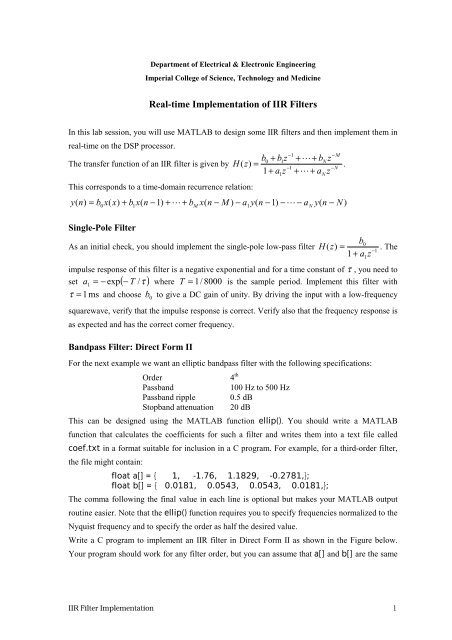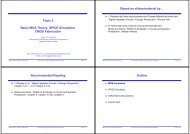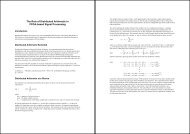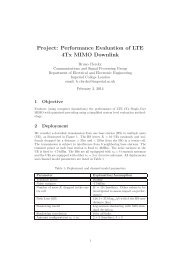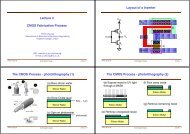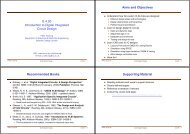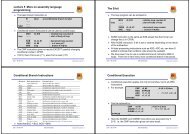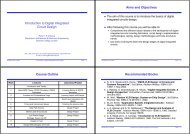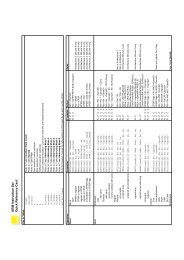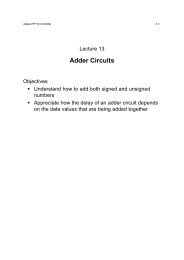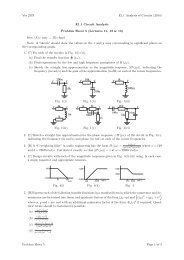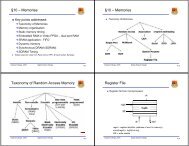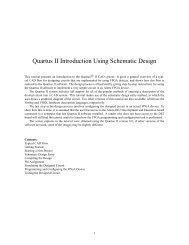Real-time Implementation of IIR Filters - Electrical Engineering
Real-time Implementation of IIR Filters - Electrical Engineering
Real-time Implementation of IIR Filters - Electrical Engineering
You also want an ePaper? Increase the reach of your titles
YUMPU automatically turns print PDFs into web optimized ePapers that Google loves.
Department <strong>of</strong> <strong>Electrical</strong> & Electronic <strong>Engineering</strong>Imperial College <strong>of</strong> Science, Technology and Medicine<strong>Real</strong>-<strong>time</strong> <strong>Implementation</strong> <strong>of</strong> <strong>IIR</strong> <strong>Filters</strong>In this lab session, you will use MATLAB to design some <strong>IIR</strong> filters and then implement them inreal-<strong>time</strong> on the DSP processor.−1−Mb0+ b1z + m+bNzThe transfer function <strong>of</strong> an <strong>IIR</strong> filter is given by H ( z)=.−1−N1+a1z+ m+aNzThis corresponds to a <strong>time</strong>-domain recurrence relation:y n)= b x(x)+ b x(n −1)+ m + b x(n − M ) − a y(n −1)−m− a y(n − )(0 1M1NNSingle-Pole Filterb0As an initial check, you should implement the single-pole low-pass filter H ( z)= . The−11 + a1zimpulse response <strong>of</strong> this filter is a negative exponential and for a <strong>time</strong> constant <strong>of</strong> τ , you need toset a1 = − exp( − T /τ ) where T = 1/ 8000 is the sample period. Implement this filter withτ = 1ms and choose b 0to give a DC gain <strong>of</strong> unity. By driving the input with a low-frequencysquarewave, verify that the impulse response is correct. Verify also that the frequency response isas expected and has the correct corner frequency.Bandpass Filter: Direct Form IIFor the next example we want an elliptic bandpass filter with the following specifications:Order4 thPassband100 Hz to 500 HzPassband ripple 0.5 dBStopband attenuation 20 dBThis can be designed using the MATLAB function ellip(). You should write a MATLABfunction that calculates the coefficients for such a filter and writes them into a text file calledcoef.txt in a format suitable for inclusion in a C program. For example, for a third-order filter,the file might contain:float a[] = { 1, -1.76, 1.1829, -0.2781,};float b[] = { 0.0181, 0.0543, 0.0543, 0.0181,};The comma following the final value in each line is optional but makes your MATLAB outputroutine easier. Note that the ellip() function requires you to specify frequencies normalized to theNyquist frequency and to specify the order as half the desired value.Write a C program to implement an <strong>IIR</strong> filter in Direct Form II as shown in the Figure below.Your program should work for any filter order, but you can assume that a[] and b[] are the same<strong>IIR</strong> Filter <strong>Implementation</strong> 1
length. You can determine the filter order (which is one less than the length <strong>of</strong> a[] ) and allocatethe required temporary storage with the following statements:order = size<strong>of</strong>(a)/size<strong>of</strong>(a[0]) - 1;w = (float *) calloc(order, size<strong>of</strong>(float));You may require the w[] array to be <strong>of</strong> length order or order+1 according to the nature <strong>of</strong> youralgorithm. Verify that the filter frequency response agrees with the MATLAB prediction.xin+–a 1Db 0–a 3Db 1–a 2D b 2b 3+youtUse the pr<strong>of</strong>iler to determine how many instruction cycles per sample are needed for are neededfor a filter <strong>of</strong> order n in the form A + Bn . You should include only the instructions between thecalls to AD535_HWI_read() and AD535_HWI_write().Now recompile your program but using the Compiler option –o2 to optimise the program forspeed. See what difference this makes to the number <strong>of</strong> instruction cycles required.Bandpass Filter: Direct Form II TransposedRewrite your program so that it implements a Direct Form II Transposed structure:xin+b 3Db 2b 1b 0+ D + D +yout–a 3–a 2–a 1Verify that the filter response is unchanged. Determine the cycle count with and withoutoptimisation.<strong>IIR</strong> Filter <strong>Implementation</strong> 2
Optional Bit for extra marksCascaded Biquad <strong>Implementation</strong>Write the code to implement a filter as a cascade <strong>of</strong> second-order (biquad) filters. You can useany <strong>of</strong> the direct form implementations as the basic building block: I have shown Direct Form IIbelow:xin gyout++ ++–a 11Db 11–a D12b 12–a 21Db 21–a D22b 222H1+b z+ bz1+b+ b−1−2−1−211 12K1K 2( z)= g ×× ×−1−2−1−1+a11z+ a12z1+aK1z+ aK2zNote that you only need a single gain coefficient, g, for the whole filter and do not needindividual b0coefficients for each stage. You may find it easiest to have four separate coefficientarrays for the a* 1, a*2,b*1, b*2values. In MATLAB, you can convert a direct-form filter intocascaded second-order sections using the function tf2sos(). Verify that your bandpass filterworks correctly.The main reason for using a cascaded biquad implementation is that it is much less sensitive tocoefficient errors. To see this, design the following enhanced version <strong>of</strong> your filter and try it outusing both your direct form and your biquad versions:Order12 thPassband100 Hz to 500 HzPassband ripple 0.5 dBStopband attenuation 40 dBYou will probably find that your direct form filter doesn’t work: to see what is going wrong, usethe watch window to examine the signal values. Even for a comparatively uncomplicated filtersuch as this, the coefficients need to be fantastically precise. MATLAB works to a precision <strong>of</strong>52 significant bits but we can artificially reduce the precision to n bits with the following routine:function y=bitsprec(x,n)[x,e]=log2(x);y=pow2(round(pow2(x,n)),e-n);endBy evaluating abs(roots(bitsprec(a,n))) for various values <strong>of</strong> n, determine how many bits <strong>of</strong>precision are required to ensure that the 12 th order filter is stable (a decimal digit corresponds to3.3 bits). Do the same for the biquad filter sections.zz<strong>IIR</strong> Filter <strong>Implementation</strong> 3


